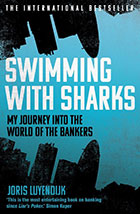 The financial crisis of 2008 has not only led regulators and governments to scrutinise how the world of finance works, but also forced researchers and journalists to conduct their own investigations into the matter. We have had the privilege to read many such masterpieces over the past seven years, but nothing has been as simple and self-explanatory as Joris Luyendijk’s book Swimming with Sharks. Luyendijk is a Dutch investigative journalist who has more experience of Gaza and Lebanon than the financial districts of London, and whose knowledge about the banking sector was scant at best. Like many, he also believed that bankers were ruthless, competitive, bonus-obsessed sharks and irrelevant to his life. Then, he was assigned to investigate the financial sector in London. Luyendijk’s candid interviews reveal some chilling details about the banking world, but there other very human aspects that give you a very different perspective.
The financial crisis of 2008 has not only led regulators and governments to scrutinise how the world of finance works, but also forced researchers and journalists to conduct their own investigations into the matter. We have had the privilege to read many such masterpieces over the past seven years, but nothing has been as simple and self-explanatory as Joris Luyendijk’s book Swimming with Sharks. Luyendijk is a Dutch investigative journalist who has more experience of Gaza and Lebanon than the financial districts of London, and whose knowledge about the banking sector was scant at best. Like many, he also believed that bankers were ruthless, competitive, bonus-obsessed sharks and irrelevant to his life. Then, he was assigned to investigate the financial sector in London. Luyendijk’s candid interviews reveal some chilling details about the banking world, but there other very human aspects that give you a very different perspective.
The journalist spoke to elite hedge fund managers, million-dollar-bonus-earning investment bankers, demoralised back-office staff, unloved HR managers and those made redundant in the industry’s regular ‘culls’. These insiders confessed to being overwhelmed by the technological and mathematical opacity in the business. When Lehman Brothers went down in 2008, they said they hoarded food, put their money in gold and prepared to evacuate their children to the countryside. They also said that nothing has changed since the crash.
However, most agreed that even if there are rotten apples on every tree, they get weeded out quickly. Luyendijk says that while from the outside it looks like business as usual, there is total fear inside. And although there are a tonne of new rules, the DNA of the sector is intact: the same conflicts of interest, same perverse incentives and same mentality. The crisis is going to happen again, he adds, except this time we may not have the money or time to bail out banks and avert the real catastrophe.
Luyendijk explains that finance does not so much need a better culture or nicer bankers as it does a better architecture. It should no longer be legal or lucrative for a banker to act against the interests of clients, shareholders, taxpayers, the economy, or even the bank itself. But how will this be implemented? After all, banks are organised globally, so they can play off one country against the other. The book explains that very large and complex financial firms often end up creating ‘too big to fail’ institutions that do not internalise the social risks of their actions.
After reading the book, one can clearly see through the vulnerability of individual bankers in the system and the way excessive risk-taking has affected its stability. But the author says we need to have faith that regulators and individual bankers will strive for better regulated, sustainable and stable institutions, without any shortcuts. But Luyendijk ends the book on a chilling note, asking, ‘What if the bankers themselves aren’t the real enemy? What if the truth about global finance is more sinister than that?’











